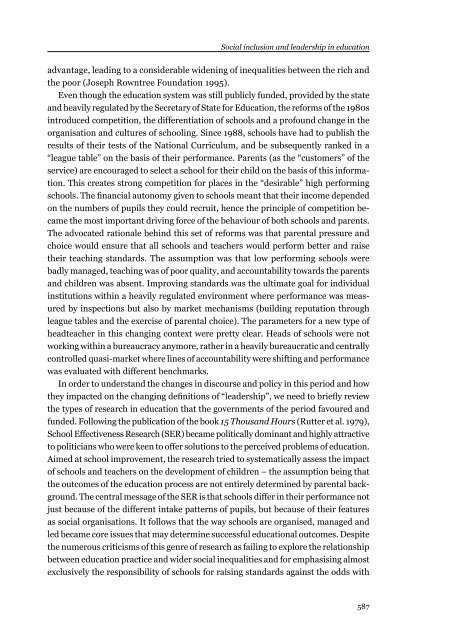Social inclusion and leadership in education: An evolution of roles ...
Social inclusion and leadership in education: An evolution of roles ...
Social inclusion and leadership in education: An evolution of roles ...
- No tags were found...
Create successful ePaper yourself
Turn your PDF publications into a flip-book with our unique Google optimized e-Paper software.
<strong>Social</strong> <strong><strong>in</strong>clusion</strong> <strong>and</strong> <strong>leadership</strong> <strong>in</strong> <strong>education</strong>advantage, lead<strong>in</strong>g to a considerable widen<strong>in</strong>g <strong>of</strong> <strong>in</strong>equalities between the rich <strong>and</strong>the poor (Joseph Rowntree Foundation 1995).Even though the <strong>education</strong> system was still publicly funded, provided by the state<strong>and</strong> heavily regulated by the Secretary <strong>of</strong> State for Education, the reforms <strong>of</strong> the 1980s<strong>in</strong>troduced competition, the differentiation <strong>of</strong> schools <strong>and</strong> a pr<strong>of</strong>ound change <strong>in</strong> theorganisation <strong>and</strong> cultures <strong>of</strong> school<strong>in</strong>g. S<strong>in</strong>ce 1988, schools have had to publish theresults <strong>of</strong> their tests <strong>of</strong> the National Curriculum, <strong>and</strong> be subsequently ranked <strong>in</strong> a“league table” on the basis <strong>of</strong> their performance. Parents (as the “customers” <strong>of</strong> theservice) are encouraged to select a school for their child on the basis <strong>of</strong> this <strong>in</strong>formation.This creates strong competition for places <strong>in</strong> the “desirable” high perform<strong>in</strong>gschools. The f<strong>in</strong>ancial autonomy given to schools meant that their <strong>in</strong>come dependedon the numbers <strong>of</strong> pupils they could recruit, hence the pr<strong>in</strong>ciple <strong>of</strong> competition becamethe most important driv<strong>in</strong>g force <strong>of</strong> the behaviour <strong>of</strong> both schools <strong>and</strong> parents.The advocated rationale beh<strong>in</strong>d this set <strong>of</strong> reforms was that parental pressure <strong>and</strong>choice would ensure that all schools <strong>and</strong> teachers would perform better <strong>and</strong> raisetheir teach<strong>in</strong>g st<strong>and</strong>ards. The assumption was that low perform<strong>in</strong>g schools werebadly managed, teach<strong>in</strong>g was <strong>of</strong> poor quality, <strong>and</strong> accountability towards the parents<strong>and</strong> children was absent. Improv<strong>in</strong>g st<strong>and</strong>ards was the ultimate goal for <strong>in</strong>dividual<strong>in</strong>stitutions with<strong>in</strong> a heavily regulated environment where performance was measuredby <strong>in</strong>spections but also by market mechanisms (build<strong>in</strong>g reputation throughleague tables <strong>and</strong> the exercise <strong>of</strong> parental choice). The parameters for a new type <strong>of</strong>headteacher <strong>in</strong> this chang<strong>in</strong>g context were pretty clear. Heads <strong>of</strong> schools were notwork<strong>in</strong>g with<strong>in</strong> a bureaucracy anymore, rather <strong>in</strong> a heavily bureaucratic <strong>and</strong> centrallycontrolled quasi-market where l<strong>in</strong>es <strong>of</strong> accountability were shift<strong>in</strong>g <strong>and</strong> performancewas evaluated with different benchmarks.In order to underst<strong>and</strong> the changes <strong>in</strong> discourse <strong>and</strong> policy <strong>in</strong> this period <strong>and</strong> howthey impacted on the chang<strong>in</strong>g def<strong>in</strong>itions <strong>of</strong> “<strong>leadership</strong>”, we need to briefly reviewthe types <strong>of</strong> research <strong>in</strong> <strong>education</strong> that the governments <strong>of</strong> the period favoured <strong>and</strong>funded. Follow<strong>in</strong>g the publication <strong>of</strong> the book 15 Thous<strong>and</strong> Hours (Rutter et al. 1979),School Effectiveness Research (SER) became politically dom<strong>in</strong>ant <strong>and</strong> highly attractiveto politicians who were keen to <strong>of</strong>fer solutions to the perceived problems <strong>of</strong> <strong>education</strong>.Aimed at school improvement, the research tried to systematically assess the impact<strong>of</strong> schools <strong>and</strong> teachers on the development <strong>of</strong> children – the assumption be<strong>in</strong>g thatthe outcomes <strong>of</strong> the <strong>education</strong> process are not entirely determ<strong>in</strong>ed by parental background.The central message <strong>of</strong> the SER is that schools differ <strong>in</strong> their performance notjust because <strong>of</strong> the different <strong>in</strong>take patterns <strong>of</strong> pupils, but because <strong>of</strong> their featuresas social organisations. It follows that the way schools are organised, managed <strong>and</strong>led became core issues that may determ<strong>in</strong>e successful <strong>education</strong>al outcomes. Despitethe numerous criticisms <strong>of</strong> this genre <strong>of</strong> research as fail<strong>in</strong>g to explore the relationshipbetween <strong>education</strong> practice <strong>and</strong> wider social <strong>in</strong>equalities <strong>and</strong> for emphasis<strong>in</strong>g almostexclusively the responsibility <strong>of</strong> schools for rais<strong>in</strong>g st<strong>and</strong>ards aga<strong>in</strong>st the odds with587

















